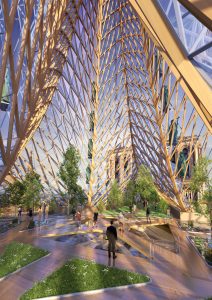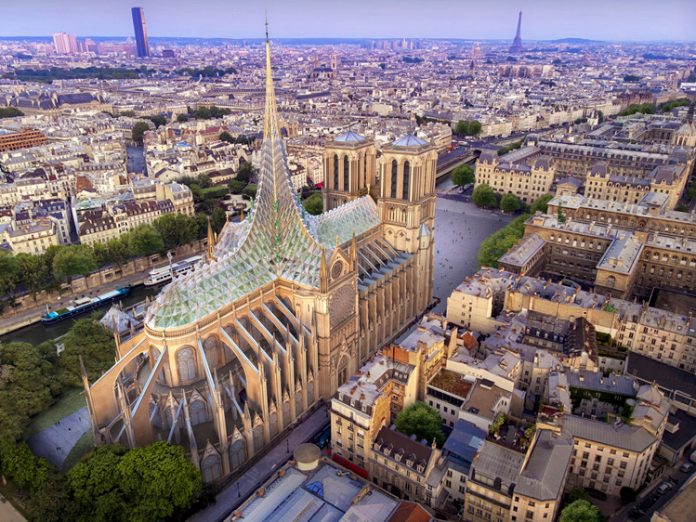Following the fire that damaged Paris’ Notre Dame Cathedral, architect Vincent Callebaut has revealed design plans that bring together ‘science, art and spirituality’
A number of proposed designs have flooded in since the French government launched an international architectural competition to redesign the roof and spire of the Notre Dame.
Vincent Callebaut has thrown its hat into the ring, which would see the roof and spire of the cathedral transformed into an eco-friendly glass roof complete with a garden.
The ‘Palingenesis’ project aims to assimilate the venerable stone nave, to blend in naturally as a vegetal graft harmonising the roof and the spire.
From the four gables, the original geometry of the 10 meter-high attic would be respected.
Constructed with cross-laminated timber (CLT) beams pre-stressed with carbon fibre slats, the new oak frame seeks to use the minimum amount of material to ensure a low-carbon footprint while offering the greatest transparency to the cathedral.
The rooster located and found in the rubble the day after the disaster will crown the spire again; in this position, it should remain the “spiritual lightning rod” and protector of the faithful.
Vincent Callebaut revealed the new architecture of the spire “evokes the rebirth but also the mystery of the cathedral and the resurrection of Christ”.
The idea is to use this new architectural “graft” to turn Notre Dame into a positive energy building, designed to produce more energy than it consumes. The contemporary, three-dimensional Gothic stained glass graft produces all the electricity, heat and passive ventilation that the cathedral might require, by combining passive systems and advanced renewable energies.

The new wooden frame is covered with a three-dimensional crystal glass dress subdivided into faceted diamond-shaped elements. These crystals consist of an organic active layer, made of carbon, hydrogen, nitrogen and oxygen, which absorbs light and transforms it into power. This energy, stored in hydrogen fuel cells, will be directly redistributed throughout the cathedral.
To avoid any greenhouse effect, these crystalline scales open at the bottom of the frame along the acroterion of the nave and transept, creating a natural air flow towards the top of the spire which mimics a wind-powered chimney.
The Palingenesis project features a garden devoted to contemplation and meditation.
Up to 21 tons of fruits and vegetables could be harvested and directly redistributed for free each year. To that end, a farmers’ market would be held every week on the forecourt of Notre-Dame.
Vincent Callebaut stated: “In conclusion, we advocate for an exemplary project in ecological engineering that feels true to its time and avoids a pastiche architecture that turns the city into an open-air museum.
“Circular economy, renewable energies, inclusive social innovation, urban agriculture, protection of biodiversity, without forgetting beauty and spiritual elevation: our reconstruction project feeds on such values to deliver a deep, conscious meaning.“














